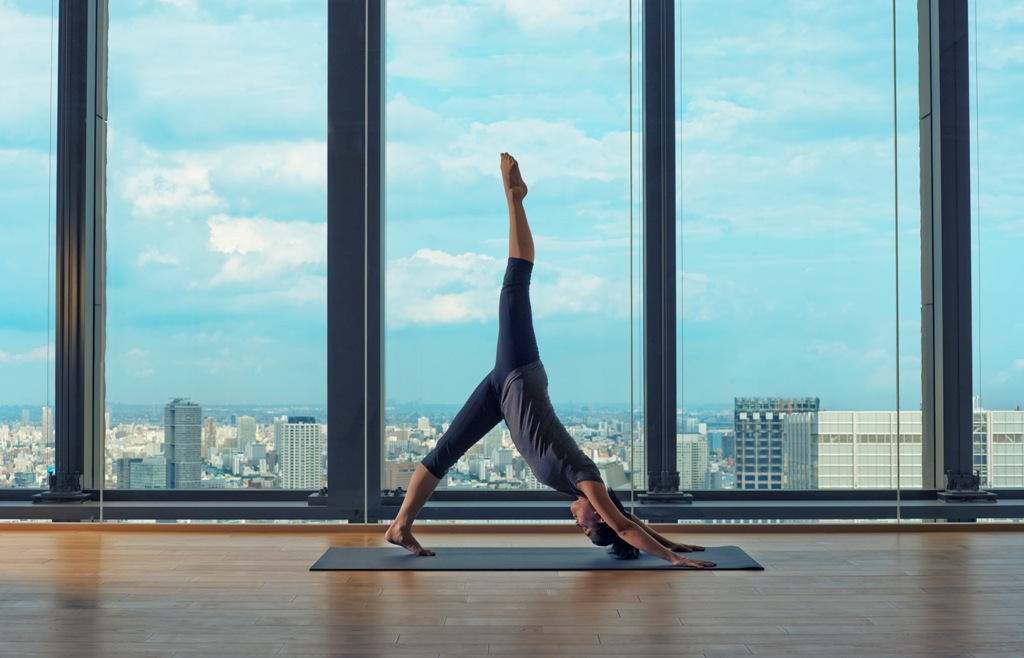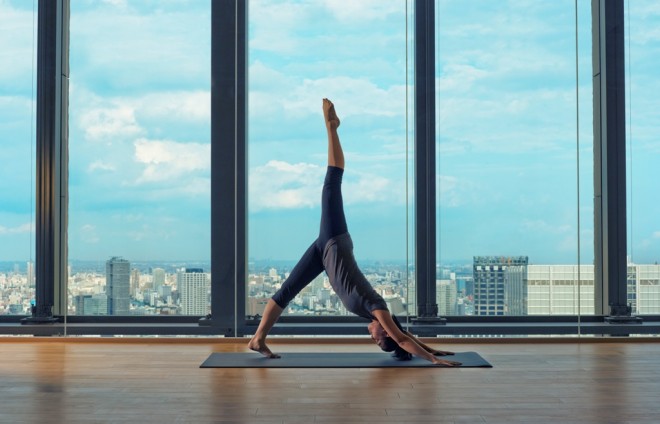
It’s the biggest, tallest and the first Aman city hotel.
Located in the prestigious financial district of Otemachi, Aman Tokyo has panoramic views of the Imperial Palace Gardens, The Tokyo Skytree and other important Japanese landmarks.
On a clear day, my room on the 38th floor accorded me a postcard-worthy view of the Imperial Gardens and Mt. Fuji. It immediately got rid of my fear that only the pure in spirit get to see Madame Fuji in the horizon.
The harmony of architecture and design, combined with elements of the local milieu, are a classic hallmark of any Aman hotel
The perfect blend of traditional Japanese design and a modern hand permeates the design vocabulary.
The lobby, at 30 meters high, 40 m long and 11 m wide, cuts through six floors of Otemachi Tower. It is majestic by any standard, particularly Tokyo’s.
The monumental lobby, referred to as “the Lantern,” is defined with layers of textured washi paper and shoji frames, allowing diffused super light to illuminate it during the day; in the evenings they evolve into a series of orchestrated lighting scenes within a voluminous space.
Central in the lobby is an inner garden that celebrates the Ikebana art form, sitting on top of a calming water feature and complemented by two traditional rock gardens.
Designed to reflect the feeling of Zen, the rock gardens feature boulders from northern Japan, and are minimal in design and meant to calm the mind, drawing it away from everyday concerns toward an appreciation for nature in the raw.
Michelin-star restaurants
The inner garden is surrounded by an engawa, a Japanese term for a wooden space between the garden and living areas in traditional homes.
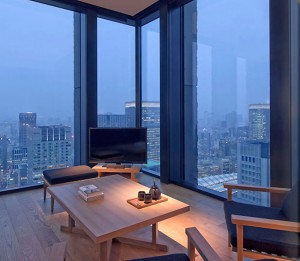
Tokyo has more Michelin-star restaurants than any other city. On the ground floor and nestled within the 3,600 square meters of the Otemachi Forest, The Café by Aman specializes in Mediterranean-inspired fare featuring the hotel’s own signature sake, and will offer lunch and dinner with outdoor forest view seating.
On the 33rd level, with floor-to-ceiling windows framing views of the Imperial Palace Gardens and Mt. Fuji in the distance, The Lounge by Aman is a casual venue for a drink or snack throughout the day and into the night.
It serves a flavorful Wagyu Bolognese and a light Caesar salad topped with a sliver of smoked duck.
The Restaurant by Aman offers gastronomic fine dining based on Mediterranean cuisine, including a selection of Japanese and Asian-inspired dishes.
Working with exclusive winemakers from around the world, as well as one of Japan’s most revered sake masters, the cellar is stocked with over 1,200 carefully selected wines in floor-to-ceiling glass-encased wine cavs.
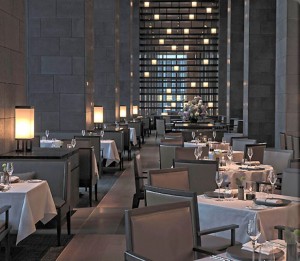
A stunning book-lined wall in Residents Library and a Cigar Lounge with a built-in humidor are staples in any Aman.
Meticulously designed for both leisure and business travelers, Aman Tokyo’s 84 rooms and suites are spacious and modern, consistently drawing inspiration from the Japanese aesthetic.
Bathing ritual
Each room and suite has a large furo—a deep soaking tub and a core part of the Japanese ritual of bathing.
Also provided is freshly sliced yuzu in a net, a well-known favorite Japanese fruit that plays a central role in Japanese cuisine. The light citrus aroma of yuzu both relaxes and energizes when you draw your bath. This, coupled with the healing properties of Japan’s volcanic mineral salts, is reminiscent of a traditional onsen in Hakone.
Facing the Imperial Palace Gardens, Deluxe Rooms, at 71 sq m, are the largest entry-level rooms in the city.
The suites, starting at 141 sq m, feature spacious open-plan living rooms and pantries. Corner suites provide panoramic views from the corners of the building.
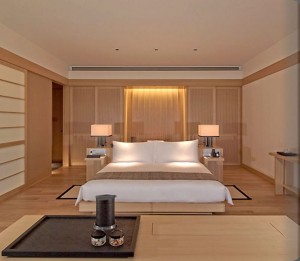
Aman Suites are the largest at 157 sq m, offering an abundance of space and spectacular views.
The materials used are a meticulous study in wood and stone, with an extensive application all throughout. There’s ash for floors and furniture at the Garden Reception; castor aralia for walls and room furniture; chestnut for the floors of guest rooms, the spa and the yoga room; 80- to 250-year-old camphor wood for all large solid wood reception desks; and Japanese cypress for bath stools.
Wellness
The stone all throughout is a range of basalt (genbu gan) of igneous rock and granite (kakou gan), also of igneous rock. Any wood and stone lover would truly eat their heart out.
Wellness has always been at the core of all Aman hotels
Based on the knowledge and wisdom of ancient philosophies and natural healing traditions, Aman Spa’s product range works holistically to nurture the skin and enhance overall wellbeing.
Made using the highest-quality natural ingredients known for their antiaging and balancing qualities, Aman’s skincare products help nourish and rejuvenate the skin.
I find that the facial oils made of rice are perfect for both tropical and temperate weather. They don’t clog the pores. You apply sparingly in the summer and generously in the winter.
As with every Aman Spa, the Tokyo spa menu features a number of locally inspired seasonal spa journeys which can be tailored to individual needs.
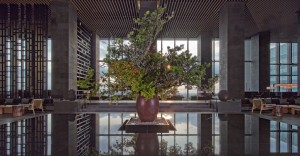
Reflecting the traditional practice of misogi, the water-based act of purification undertaken before any journey, guests are invited to use the hot baths or steam facilities to relax and unwind prior to beginning their treatment.
Each spa journey begins with a foot bath using seasonal kampo herbs with mineral sea salt and a breathing ritual using camphor tree oil, known for its relaxing and calming properties.
The slow-paced rituals force one to stop and breathe slowly. I have yet to try the signature treatment, but I must say the rituals of the Seasonal Spring Journey were very rejuvenating. Inspired by the sakura, it makes one look forward to the delights of spring.
The art elements never assault or draw attention. Whether it be a mural, sculpture or painting, large or small, everything just fits seamlessly into the spaces.
I particularly like the triptych by the plasterer Shuhei Hasado. The plasterwork represents an ascending flow of “the earth,” “the branches,” and on Level 33, “the flower.” Hasado depicts nature in its present forms without unnecessary ornamentation.
My five-day business trip with one of my favorite clients kept me outside the Aman Tokyo most of the day. So, why stay at an Aman if you will be out most of the day?
I say, coming home at night to a wonderful, large, well-appointed room with impeccable quality to soak in a traditional stone furo, as if you were in
an onsen with a spectacular evening view of the city skyline, defines a very special kind of urban luxury for the business traveler.
It would be nice to go back on a holiday to savor all the offerings of the hotel, and yet be able to go out and shop and dine till you drop. Now that’s a nice urban holiday!
In the words of Jeffrey Seward, the very affable Aman GM: “Home is not a place, it is a feeling.” Once again, The Aman Group redefines a new standard of luxury.
For comments, e-mail majaolivaresco@gmail.com.

